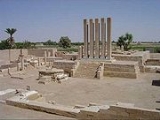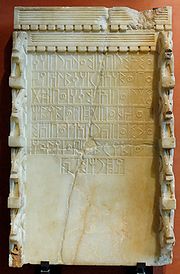
Sabaeans
Encyclopedia
The Sabaeans or Sabeans were an ancient people speaking an Old South Arabian
language who lived in what is today Yemen
, in the south west of the Arabian Peninsula
.
Some scholars suggest a link between the Sabaeans and the Biblical land of Sheba
.

 The ancient Sabaean Kingdom established power in the early 1st millennium BC. In the 1st century BC it was conquered by the Himyar
The ancient Sabaean Kingdom established power in the early 1st millennium BC. In the 1st century BC it was conquered by the Himyar
ites, but after the disintegration of the first Himyarite empire of the Kings of Saba' and Dhu-Raydan, the Middle Sabaean Kingdom reappeared in the early 2nd century. It was finally conquered by the Himyarites in the late 3rd century. Its capital was Ma'rib
. The kingdom was located along the strip of desert
called Sayhad
by medieval Arab
geographers and that is called now Ramlat al-Sab`atayn
.
The Sabaean people were South Arabian
people. Each of these had regional kingdoms in ancient Yemen, with the Minaeans in the north along the Red sea
, the Sabeans on the south western tip, stretching from the highlands to the sea, the Qatabanians to the east of them and the Hadramites east of them.
The Sabaeans, like the other Yemenite
kingdoms of the same period, were involved in the extremely lucrative spice trade
, especially frankincense
and myrrh
.
They left behind many inscriptions in the monumental Musnad
(Old South Arabian) alphabet, as well as numerous documents in the cursive Zabur script.
In the Res Gestae Divi Augusti
, Augustus
claims that:
Old South Arabian
Old South Arabian is the term used to describe four extinct, closely related languages spoken in the far southern portion of the Arabian Peninsula. There were a number of other Sayhadic languages , of which very little evidence survived, however...
language who lived in what is today Yemen
Yemen
The Republic of Yemen , commonly known as Yemen , is a country located in the Middle East, occupying the southwestern to southern end of the Arabian Peninsula. It is bordered by Saudi Arabia to the north, the Red Sea to the west, and Oman to the east....
, in the south west of the Arabian Peninsula
Arabian Peninsula
The Arabian Peninsula is a land mass situated north-east of Africa. Also known as Arabia or the Arabian subcontinent, it is the world's largest peninsula and covers 3,237,500 km2...
.
Some scholars suggest a link between the Sabaeans and the Biblical land of Sheba
Sheba
Sheba was a kingdom mentioned in the Jewish scriptures and the Qur'an...
.
History


Himyar
The Himyarite Kingdom or Himyar , historically referred to as the Homerite Kingdom by the Greeks and the Romans, was a kingdom in ancient Yemen. Established in 110 BC, it took as its capital the modern day city of Sana'a after the ancient city of Zafar...
ites, but after the disintegration of the first Himyarite empire of the Kings of Saba' and Dhu-Raydan, the Middle Sabaean Kingdom reappeared in the early 2nd century. It was finally conquered by the Himyarites in the late 3rd century. Its capital was Ma'rib
Ma'rib
Ma'rib or Marib is the capital town of the Ma'rib Governorate, Yemen and was the capital of the Sabaean kingdom, which some scholars believe to be the ancient Sheba of biblical fame. It is located at , approximately 120 kilometers east of Yemen's modern capital, Sana'a...
. The kingdom was located along the strip of desert
Desert
A desert is a landscape or region that receives an extremely low amount of precipitation, less than enough to support growth of most plants. Most deserts have an average annual precipitation of less than...
called Sayhad
Sayhad
Sayhad is a desert region that corresponds with Northern Deserts of Modern Yemen and Southwestern Saudi Arabia ....
by medieval Arab
Arab
Arab people, also known as Arabs , are a panethnicity primarily living in the Arab world, which is located in Western Asia and North Africa. They are identified as such on one or more of genealogical, linguistic, or cultural grounds, with tribal affiliations, and intra-tribal relationships playing...
geographers and that is called now Ramlat al-Sab`atayn
Ramlat al-Sab`atayn
The Ramlat al-Sab`atayn is a region of desert in north-central Yemen. It comprises mainly transverse and seif dunes and covers an area of about 60 by , roughly 10,000 square miles. The area includes what was known to medieval Arab geographers as the Sayhad....
.
The Sabaean people were South Arabian
South Arabian
The Modern South Arabian languages are spoken mainly by minority populations in the Arabian Peninsula in Yemen and Oman, which, together with the Ethiopian Semitic languages, form the Western South Semitic branch. In his glottochronology-based classification, A...
people. Each of these had regional kingdoms in ancient Yemen, with the Minaeans in the north along the Red sea
Red Sea
The Red Sea is a seawater inlet of the Indian Ocean, lying between Africa and Asia. The connection to the ocean is in the south through the Bab el Mandeb strait and the Gulf of Aden. In the north, there is the Sinai Peninsula, the Gulf of Aqaba, and the Gulf of Suez...
, the Sabeans on the south western tip, stretching from the highlands to the sea, the Qatabanians to the east of them and the Hadramites east of them.
The Sabaeans, like the other Yemenite
Yemenite
Yemenite may refer to:*Yemenite, a person from Yemen*Yemeni Arabic, dialect of the Arabic language*Yemenite step, an Israeli folk dance step originating from Yemen*Yemenite Jews...
kingdoms of the same period, were involved in the extremely lucrative spice trade
Spice trade
Civilizations of Asia were involved in spice trade from the ancient times, and the Greco-Roman world soon followed by trading along the Incense route and the Roman-India routes...
, especially frankincense
Frankincense
Frankincense, also called olibanum , is an aromatic resin obtained from trees of the genus Boswellia, particularly Boswellia sacra, B. carteri, B. thurifera, B. frereana, and B. bhaw-dajiana...
and myrrh
Myrrh
Myrrh is the aromatic oleoresin of a number of small, thorny tree species of the genus Commiphora, which grow in dry, stony soil. An oleoresin is a natural blend of an essential oil and a resin. Myrrh resin is a natural gum....
.
They left behind many inscriptions in the monumental Musnad
Musnad
Musnad may refer to:*South Arabian alphabet*Musnad hadith*Musnad Ahmad ibn Hanbal...
(Old South Arabian) alphabet, as well as numerous documents in the cursive Zabur script.
In the Res Gestae Divi Augusti
Res Gestae Divi Augusti
Res Gestae Divi Augusti, is the funerary inscription of the first Roman emperor, Augustus, giving a first-person record of his life and accomplishments. The Res Gestae is especially significant because it gives an insight into the image Augustus portrayed to the Roman people...
, Augustus
Augustus
Augustus ;23 September 63 BC – 19 August AD 14) is considered the first emperor of the Roman Empire, which he ruled alone from 27 BC until his death in 14 AD.The dates of his rule are contemporary dates; Augustus lived under two calendars, the Roman Republican until 45 BC, and the Julian...
claims that:
External links
- S. Arabian "Inscription of Abraha" in the Sabaean language, at Smithsonian/NMNH website

